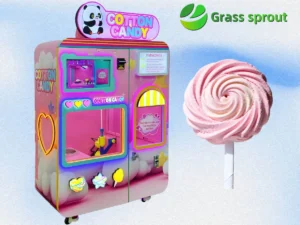Cotton candy vending machines have been around for a while now and are quickly becoming one of the most profitable investments for mall owners, amusement parks, high-traffic retail areas, and more. People love the interactive aspect and beautiful design of these machines, but many first-time owners have a lingering question about power consumption:
“Will these machines eat up my electricity bill?”
Well, let’s take a look at what’s typical based on actual machine ratings, normal daily volume, and some tips to use power more efficiently…
🔌 1. Understanding Your Machine’s Power Specs
Most standard machines use either:
- 110V at 25 amps, or
- 220V at 10 amps
These settings work out to a range between 400W and 2500W, depending on which components are activated and for how long.
Here’s a closer look at the big three:
| Component | Power Range | Activation Time per Cycle |
| Heating System (Sugar Melter) | 1000–2000W | 1–2 mins |
| Motor & Spinner | 50–100W | 1–2 mins |
| Display & Lights | 50–200W | Constant or on-demand |
| Cooling Fan (optional) | 100–200W | As needed |
At a rate of 60–90 seconds per cotton candy, it’s the heating element that takes the biggest power hit, and the rest only draws small amounts.
💡 2. Calculating Annual Electricity Usage
Let’s use a realistic example.
✅ Scenario:
- Daily operations: 100 sales/day
- Each cycle: ~1.5 minutes at ~1800W
- Idle time: ~10 hours/day at ~100W (display + electronics)
⚙️ Estimated Daily Energy Use:
- Active production: 100 sales × 1.5 mins = 150 minutes → 4.5 kWh/day
- Idle standby: 10 hours × 0.1 kW = 1.0 kWh/day
→ Total: ~5.5 kWh/day
🔢 Annual Use:
5.5 kWh × 365 days = ~2,007 kWh/year
💵 Electricity Cost (at $0.12 per kWh):
2007 × $0.12 = ~$240.84/year
📊 3. Comparing to Other Vending Machines
| Machine Type | Yearly Energy Use | Approx. Cost |
| Cotton Candy (your machine) | 1800–2200 kWh | $216 – $264 |
| Soda Vending Machine | 2500–4400 kWh | $300 – $528 |
| Snack Machine (non-cooled) | 400–700 kWh | $48 – $84 |
| Ice Cream Vending Unit | 3500–5000 kWh | $420 – $600 |
✅Takeaway: In general, cotton candy vending machines are in the middle range, and a good balance between performance and electricity bill.
🔍 4. What Affects Your Machine’s Power Usage
But not all cotton candy machines are created equal, and the following variables can swing your bill higher or lower:
📍 Operating Frequency
- More cycles = more heat cycles
- Machines in malls or entertainment venues will naturally use more electricity than ones in quiet cafés.
📍 Machine Design
- Some models feature variable power control, allowing the heating element to run at reduced capacity.
- LED lights and low-power touchscreens reduce idle power.
📍 Voltage Configuration
- 220V configuration often runs more efficiently than 110V due to reduced current draw and less heat loss.
📍 Local Climate
- In warmer climates, internal fans or additional insulation may be required, affecting standby power.
⚙️ 5. How to Reduce Electricity Usage (and Costs)
Even though your machine is already efficient, you can lower costs further:
✅ Use Smart Plug Monitoring
Install smart plugs (e.g., TP-Link Kasa HS110, Shelly Plug) to track real-time electricity usage and schedule operation windows.
✅ Enable Eco/Sleep Modes
Check your machine’s manual for software-based settings that:
- Power down screen/LEDs during inactivity
- Lower heating temperature in standby mode
✅ Operate During Peak Traffic Hours
Limit operation to when foot traffic is high. Many owners use motion sensors or timers to auto-activate only when users are nearby.
✅ Routine Maintenance
Dirty motors or clogged vents force systems to work harder. Clean every week to maintain airflow and prevent electrical overdraw.
🌱 Are Cotton Candy Machines Energy-Efficient?
Cotton candy vending machines are relatively energy-efficient (eco-friendly) compared to refrigeration units or cooking appliances. You don’t need to power any compressors or freezers, and smart automation can limit idle power draw.
Other options for environmentally-conscious owners and locations:
- Use biodegradable or compostable sticks or paper cups
- Source organic, unrefined sugar
- Power machines via solar-supported circuits if outdoors
🏁 Final Verdict: Is Power Usage a Concern?
Honestly, not really. At around $200–$250/year, power is a manageable and predictable operating expense—especially when you sell each candy for $3–$6.
And if you sell 50 or more per day, your gross profit is likely $4,000–$8,000 per month, which makes electricity around 0.5%–1% of your operating costs.
Bottom line: don’t let power usage be a barrier to entry and realize you’re only paying a small price to make a sweet profit with a modern cotton candy vending machine.
📞 联系方式
We’re here to help! Whether you have questions about our 全自动棉花糖售货机, want a custom quote, or need technical support — our team is ready to assist you.




